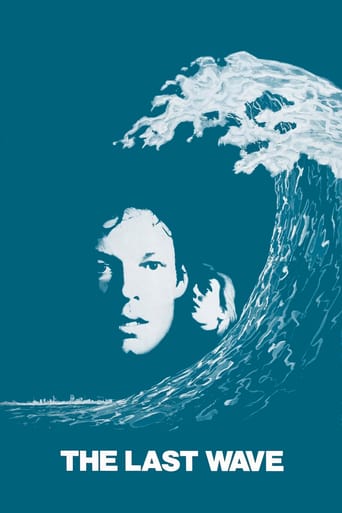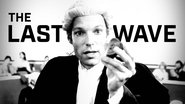sharky_55
What Weir succeeds in doing here is maintaining an atmosphere of pervasive dread throughout The Last Wave. With his massive fire hoses he will flood the vast red outback with a rare rainstorm, and then move towards his focused territory, by letting the elements smash windows and enter the man made domain. The rain-clouds hover over the urbanised city like a great grey shroud, and what little life and colour is lost in the showers. And then he will use movement in order to close into our characters. First, closeups of a trickle of water down stairs that seems almost harmless in comparison, but quickly gains momentum and a determined will of its own. Then he will slowly zoom into the family dinner table, as if the water has already reclaimed upstairs and is about to take the dining room too. It's a marvellous little bit of camera-induced claustrophobia, fear in the most apprehensive way, slow moving, implacable, unstoppable. Of course it is just a bathtub overflowing, but it begins to mean a lot more for David Burton, the Sydney-based solicitor. Unfortunately what Weir cannot do is match this with mood with an engaging, thoughtful narrative. It is not dissimilar to the problems I had with Picnic at Hanging Rock; a vague, ominous sense of foreboding, mystical powers that go unexplained, a mystery that goes beyond mankind's grasp. And it is broached in a way that has become more and more wearisome in recent times; a white man accidentally stumbles upon a thousands of years old secret, a festishsised native of the land, the mystic power that runs through their veins. David attempts to unlock the mysteries in a court session, but even more so from a modern perspective it feels like he is not only explaining this to himself, but to the audience. There is no subtext, no discourse attempted to unravel the multitude of issues regarding the Indigenous Aboriginal identity, how it is morphed within a urbanised context, how their morality is at odds with the western-centric law system, how their sense of community has been displaced, and so on. It descends into your standard horror/thriller riddled with suspense. It is a pity too, because the suspense is so well done. The visuals become a way of boring into the subconscious of David, and the awakening of his paranoia and fears - as the Mulkurul's duty is to warn of the coming apocalypse. His visions becomes surreal, and flicker between reality and dreamtime; a plague of descending frogs ala bible style, a stream of water trickling from his car dash that had just giving a rational explanation for the black globs of rain obscuring his windscreen, and then his whole car enveloped in a underwater trance. His dreams begin to haunt him - the camera moves quickly through the halls of the apartment, unnerved, as if running from an unseen beast, and then into David's own bedroom, peering down upon his place of solace, stalking, observing, threatening. Car fog-lights in the night become a shimmering, gliding phenomena, marring his rational mind. And in Wain's soundtrack, with the sinister synthesizer backing, and the soft but creeping didgerirdoo, we become aware of danger before we even see it, as though we too have inherited David's dreamlike sixth sense. But Weir veers too deeply, and what was seductive and fear-inducing becomes disorientating. He robs us of our senses by having David manoeuvre through dark tunnels and caves, and in a rare moment of genius, contrasts the feeble light of his flash-light alongside Charlie's dancing, lively flame. But he turns away, grabs blindly at a relic that may or may not be important, and staggers out into the real world again. This ending is supposed to be ambiguous, but Weir renders this effect impotent by showing the unending wrath and power of the waves of the ocean in an entirely separate frame from from David's blinking, disbelieving eyes. This seems to be the result of a small budget - and if you look carefully and spot the surfer on the beach of David's apocalyptic vision, you would tend to agree.
Takeshi-K
Australia is a weird society. It's filled with good people who enjoy a good life, a much better life than third world folk. The trouble is that good life was gained by the slaughter of it's local population, the Aboriginal people of Australia, a people whose life land and liberty was stolen from them out of sheer evil greed. These are a people that since 1788 White Australia pretends doesn't actually exist. To admit they actually exist, would open White Australia up to dealing with the guilt over its dark past, and possibly dealing with the guilt over the real source of that good life. White Australia can thus be described as a big sooky trust fund baby, every bit as daft as Paris Hilton, a blithering idiot lacking the intelligence to understand or truly appreciate the pain that was wrought to bring about her wealth that she actually, stupidly, feels she arrogantly deserves.Legendary American thinker Mark Twain once wrote that Australian history "does not read like history, but like the most beautiful lies."The fact that a British Actor, and not a White Australian actor, played the role of a White Man defending Aborigines in court in what is in point of fact, a 100% Australian movie, wholeheartedly speaks to the above. It took a foreign born actor to truthfully see the Aussie forest through its racist and pathologically disturbed trees.
Robert J. Maxwell
I remember seeing this when it was released, in a theater in Palo Alto, and not expecting much. I mean -- an Australian movie? Chips Rafferty would be in it somewhere. But it finally got to me. Here's a scene. Richard Chamberlain is sitting cross legged on the floor of a shabby apartment in Sidney, facing an Australian aborigine elder named Charlie.Chamberlain: "You were outside my house last night. You frightened my wife. Who are you?" And Charlie at a deliberate pace replies, "Who are you? Who are you? Who are you? Who are you? Who are you?. . . . Are you a fish? Are you a snake? Are you a man? . . . . Who are you? Who are you? Who are you?" It's a stunning scene, shot all in close ups, with Chamberlain's blandly handsome face filling the screen in opposition to Charlie's black, broad-nosed, unyielding bearded visage.The two guys couldn't be more different and this film is the story of how Chamberlain accidentally stumbles from his humdrum lawyerly existence into the inexplicable, almost unspeakable, mysteries of Charlie's world.I don't think I'll go on much about the plot. It's kind of an apocalyptic tale. But I must say, whoever did the research on Australian aboriginal belief systems should get an A plus. They've got everything in here, from pointing the bone to the dream time, a kind of parallel universe in which dreams are real. It's an extremely spooky movie without any musical stings or splendiferous special effects. Charly's world simply begins to intrude into Chamberlain's dreams, for reasons never made entirely clear.If there's a problem with the script, that's it. Nothing is ever made entirely clear. Does Chamberlain, who seems to have some extraordinary rapport with the aborigines, die in the last wave? Do the aborigines? Does the entirety of Sidney? The basic premise is a little hard to accept too, though granted that this is a fantasy. The aborigines are invested with the kind of spiritual power that Americans bestow on American Indians, whereas the fact is that mythology is mythology and while one may be more complex or satisfying -- more elegant and beautiful, if you like -- mythology is still an attempt to transcend an ordinary, demanding, and sometimes disappointing physical existence. The mysticism of Charlie is more convincing that the miracles of Moses in Cecil B. DeMille's "The Ten Commandments," but they're brothers under the skin.But I don't care about that. Taken as a film, this one is pretty good, and it's especially important for marking the celebrity of the director, Peter Weir, and the Australian film industry. This was the first of a great wave of films from the antipodes, some of them raucous, like "Mad Max," and some subtle and dramatic, like "Lantana." I like Weir's stuff, which resembles Nicholas Roeg's in being pregnant with subliminal dread. Try "Picnic at Hanging Rock" for an example of how to make a truly chilling movie with not a drop of blood.
dougdoepke
You know the people in the movie are in for it when king-sized hailstones fall from a clear blue sky. In fact, the weather stays pretty bad throughout this atmospheric thriller, and only lawyer Chamberlain has the answer. But he's too much the European rationalist, I gather, to get in touch with that inner being that only reveals itself through dreams.Darkly original mystery heavy on the metaphysics from director-writer Peter Weir. Already he had proved his skill at flirting with other dimensions in Picnic at Hanging Rock (1975). Here it's the arcane world of the Australian Aborigines that confronts that the tightly ordered world of the predominant whites. Something strange is going on inside the Aborigine community when they kill one of their number for no apparent reason. Yuppie lawyer Chamberlain is supposed to defend them in a white man's court. But the more he looks into things, the more mysterious things get, and the more interested a strange old Aboriginal man gets in him. And then there're those scary dreams that come and go at odd times.Well structured screenplay deepens interest throughout. One reason the movie works is the background normalcy of Chamberlain's wife and little daughters. Audiences can readily identify with them. And when their little world runs into forces beyond the usual framework, the normalcy begins to buckle, and we get the feeling of worlds beginning to collide. Chamberlain underplays throughout, especially during the underground discovery tour where I think he should have shown more growing awareness than he does. After all, it's the picking up of the mask that holds the key (I believe) to the riddle, yet his reaction doesn't really register the revelation. Of course, the notion of nature striking back has a certain resonance now, thirty years later. In the film, the notion is wrapped in a lot of entertaining hocus-pocus, but the subject itself remains a telling one. One way of bringing out a central irony is the symbolism of the opening scene. A big white SUV barrels past an aboriginal family, leaving them in the historical dust. The terrain looks like an interior tribal reservation of no particular importance to the coastal fleshpots where industry dwells. Yet, it's also a region most likely to survive anything like a destructive last wave. Perhaps there's something about past and future to think about here.Anyway, this is a really good movie that will probably stay with you.









